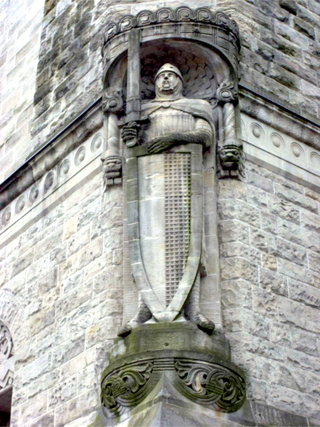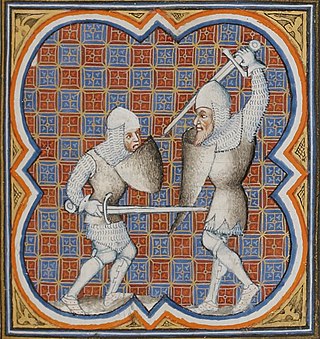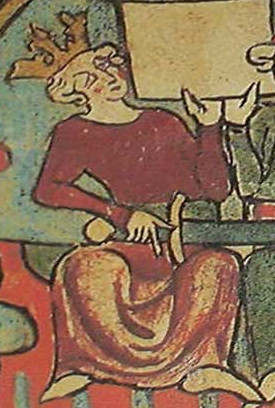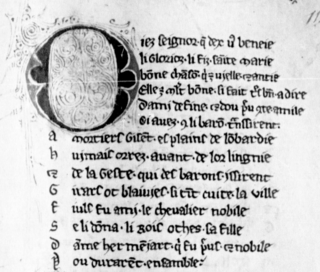
Roland was a Frankish military leader under Charlemagne who became one of the principal figures in the literary cycle known as the Matter of France. The historical Roland was military governor of the Breton March, responsible for defending Francia's frontier against the Bretons. His only historical attestation is in Einhard's Vita Karoli Magni, which notes he was part of the Frankish rearguard killed in retribution by the Basques in Iberia at the Battle of Roncevaux Pass.

The chanson de geste is a medieval narrative, a type of epic poem that appears at the dawn of French literature. The earliest known poems of this genre date from the late 11th and early 12th centuries, shortly before the emergence of the lyric poetry of the troubadours and trouvères, and the earliest verse romances. They reached their highest point of acceptance in the period 1150–1250.

Renaudde Montauban was a legendary hero and knight which appeared in a 12th-century Old French chanson de geste known as The Four Sons of Aymon. The four sons of Duke Aymon are Renaud, Richard, Alard and Guiscard, and their cousin is the magician Maugris. Renaud possesses the magical horse Bayard and the sword Froberge.
Jean Bodel, also spelled Jehan Bodel, was an Old French poet who wrote a number of chansons de geste as well as many fabliaux. He lived in Arras.

Valentine and Orson is a romance which has been attached to the Carolingian cycle.
The Matter of France, also known as the Carolingian cycle, is a body of medieval literature and legendary material associated with the history of France, in particular involving Charlemagne and the Paladins. The cycle springs from the Old French chansons de geste, and was later adapted into a variety of art forms, including Renaissance epics and operas. Together with the Matter of Britain, which concerned King Arthur, and the Matter of Rome, comprising material derived from and inspired by classical mythology, it was one of the great European literary cycles that figured repeatedly in medieval literature.

As a literary genre, the chivalric romance is a type of prose and verse narrative that was popular in the noble courts of high medieval and early modern Europe. They were fantastic stories about marvel-filled adventures, often of a chivalric knight-errant portrayed as having heroic qualities, who goes on a quest. It developed further from the epics as time went on; in particular, "the emphasis on love and courtly manners distinguishes it from the chanson de geste and other kinds of epic, in which masculine military heroism predominates."

Fierabras or Ferumbras is a fictional Saracen knight appearing in several chansons de geste and other material relating to the Matter of France. He is the son of Balan, king of Spain, and is frequently shown in conflict with Roland and the Twelve Peers, especially Oliver, whose prowess he almost rivals. Fierabras eventually converts to Christianity and fights for Charlemagne.

Ferragut was a character—a Saracen paladin, sometimes depicted as a giant—in texts dealing with the Matter of France, including the Historia Caroli Magni, and Italian epics, such as Orlando Innamorato by Matteo Maria Boiardo and Orlando Furioso by Ludovico Ariosto. In the tales, he was portrayed as physically invulnerable except at his navel/stomach, and was eventually killed by the paladin Roland.

The Historia Caroli Magni, also known as the Historia Karoli Magni et Rotholandi or the (Pseudo-)Turpin Chronicle, is a 12th-century Latin chronicle consisting of legendary material about Charlemagne's campaigns in Spain. The chronicle states it was written by Charlemagne's contemporary Turpin, Archbishop of Reims, but it was found out as a medieval forgery. The work was extremely popular, and served as a major source of material on Charlemagne in chronicles, fiction and iconography throughout Medieval Europe. The miracles of the flowering lances and the death of Ferracutus appear on the windows of Chartres cathedral.

Le Pèlerinage de Charlemagne is an Old French chanson de geste dealing with a fictional expedition by Charlemagne and his paladins. The oldest known written version was probably composed around 1140. Two 15th-century reworkings of the story are also known.

The riddarasögur are Norse prose sagas of the romance genre. Starting in the thirteenth century with Norse translations of French chansons de geste and Latin romances and histories, the genre expanded in Iceland to indigenous creations in a similar style.
Agolant or Agolante is a fictional character in Medieval and Renaissance romantic epics dealing with the Matter of France, including Orlando innamorato by Matteo Maria Boiardo and Orlando furioso by Ludovico Ariosto. He is a Saracen king from Africa.
The Karlamagnús saga, Karlamagnussaga or Karlamagnus-saga was a late-thirteenth-century Norse prose compilation and adaptation, made for Haakon V of Norway, of the Old French chansons de geste of the Matter of France dealing with Charlemagne and his paladins. In some cases, the Karlamagnús saga remains the only source for otherwise-lost Old French epics.

Galiens li Restorés, or Galien le Restoré or Galien rhétoré, is an Old French chanson de geste which borrows heavily from chivalric romance. Its composition dates anywhere from the end of the twelfth century to the middle of the fourteenth century. Five versions of the tale are extant, dating from the fifteenth century to the sixteenth century, one in verse and the others in prose. The story—which is closely linked to the earlier chansons de gestePèlerinage de Charlemagne and The Song of Roland —tells of the adventures of Galien, son of the hero Olivier and of Jacqueline, the daughter of the (fictional) emperor Hugon of Constantinople.
Amis and Amiloun is a Middle English romance in tail rhyme from the late thirteenth century. The 2508-line poem tells the story of two friends, one of whom is punished by God with leprosy for engaging in a trial by ordeal after the other has been seduced and betrayed. The poem is praised for the technical competency displayed in the stanzaic organization, though its quality as a chivalric romance has been debated. It is found in four manuscripts ranging from c. 1330 to c. 1500, including the Auchinleck Manuscript.
Jean Bagnyon or Jehan Bagnyon was a lawyer, historian, political writer, and translator born in 1412, in Croy, in the canton of Vaud, which was, at that time, a part of the Duchy of Savoy. He died sometime after 1487.
Audradus Modicus was a Frankish ecclesiastic and author during the Carolingian Renaissance. He wrote in Latin.
Amícus saga ok Amílius is a medieval Icelandic romance saga. Probably from the fourteenth century, it was translated from Vincent de Beauvais's Speculum historiale, probably during the reign of Haakon V of Norway, and tells a similar story to the related French romance Amis et Amiles. The saga survives in only one manuscript, Stockholm, Royal Library Perg 4to nr 6. The saga has enjoyed extensive critical discussion.

Jordain de Blaivies is an Old French chanson de geste written in decasyllables around 1200. It is an adventure story, largely inspired by the ancient story of Apollonius of Tyre. It survives in a single manuscript. The original was never popular, but it was reworked into a different metre and also adapted into prose in the 15th century. The prose version was printed with illustrations in 1520.















